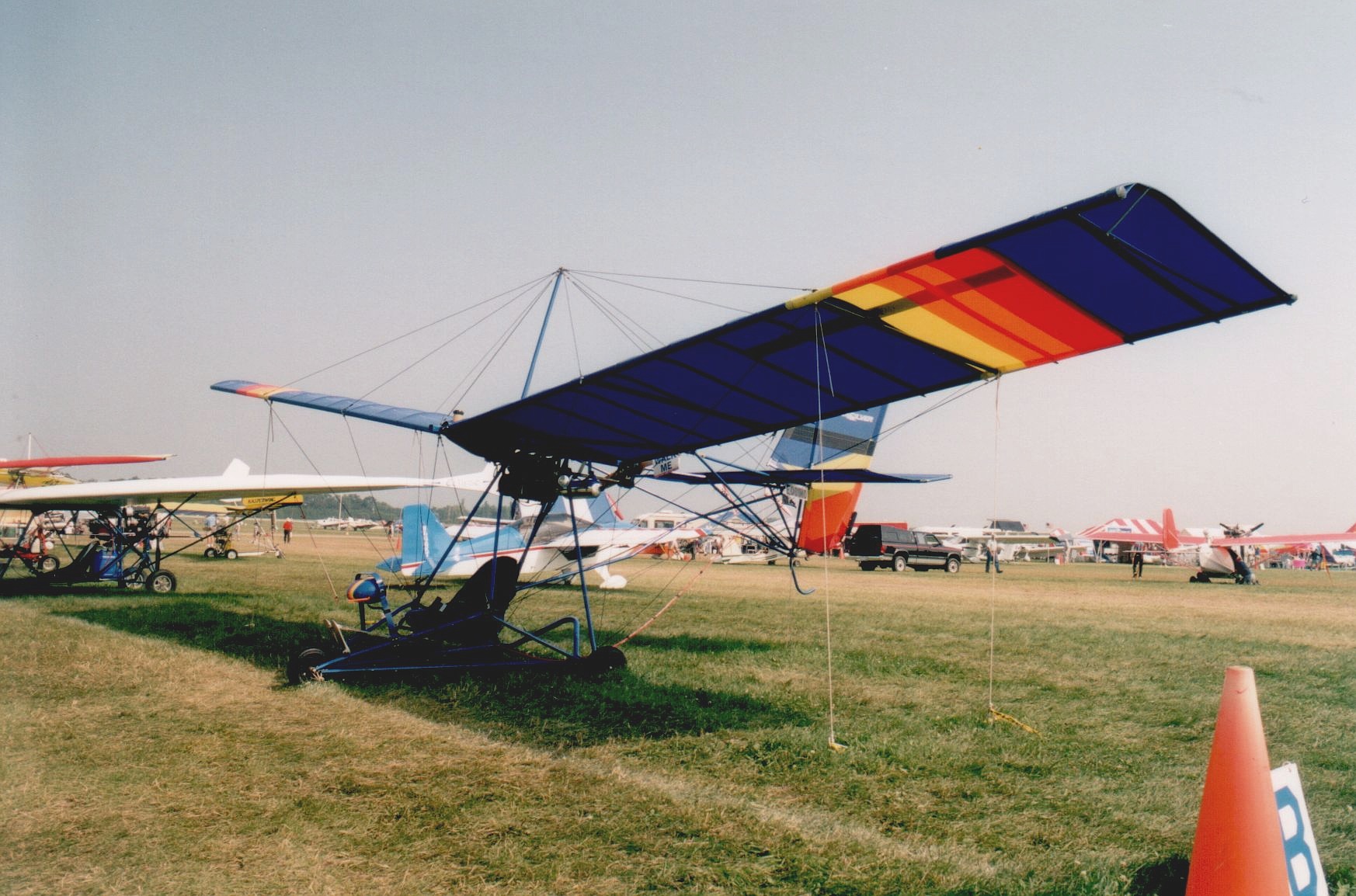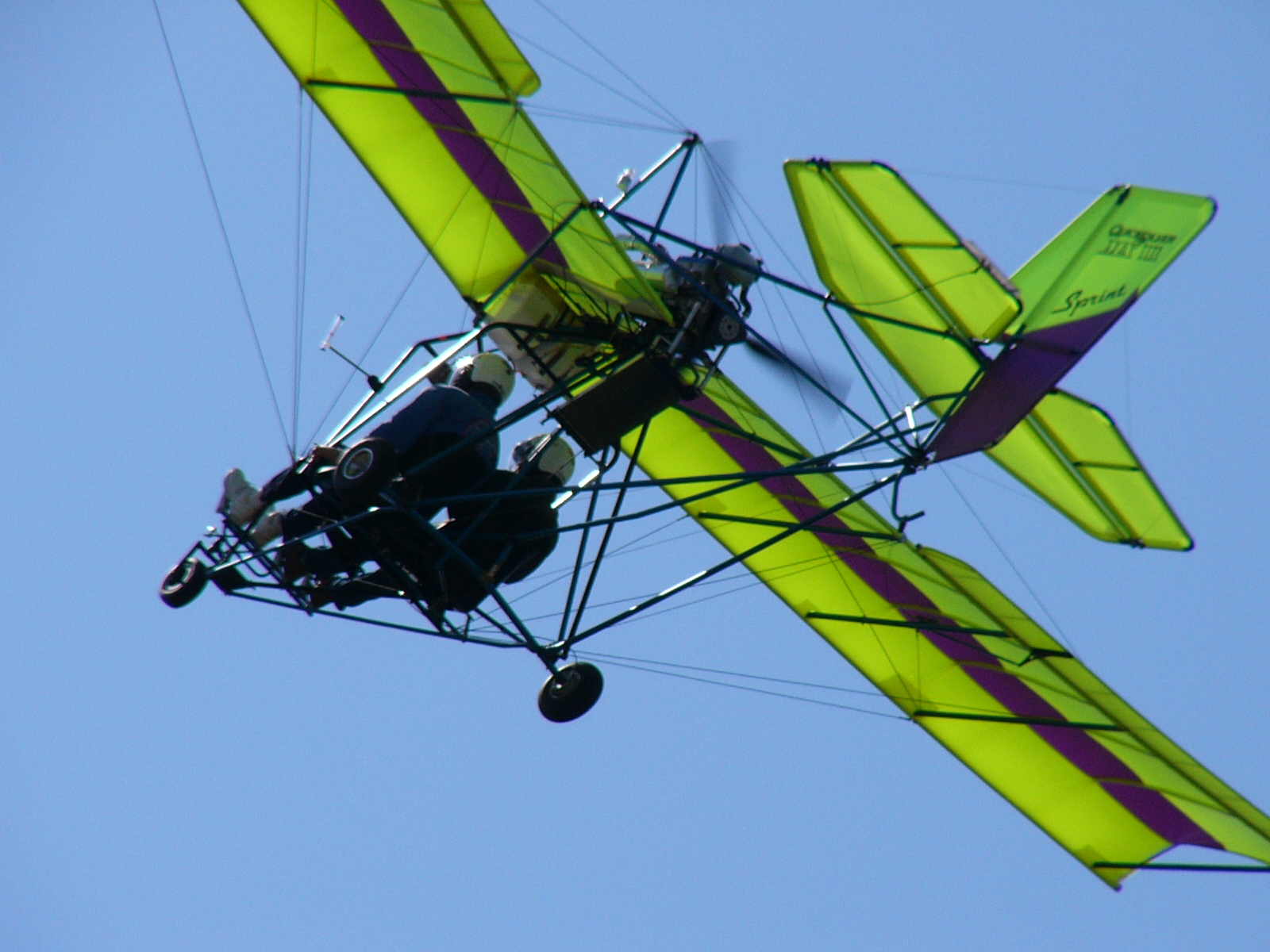Eipper Quicksilver on:
[Wikipedia]
[Google]
[Amazon]
Quicksilver is a line of single and two-place high wing, single-engine,
 In the summer of 1982, Peter Burgher modified a Quicksilver MX-1 with longer wings, larger fuel tanks, and modified carburetor jets flew from
In the summer of 1982, Peter Burgher modified a Quicksilver MX-1 with longer wings, larger fuel tanks, and modified carburetor jets flew from


 ;Quicksilver C
:The C model was the earliest powered version and consisted of the Quicksilver hang glider, including the weight-shift sling seat, with a McCulloch MAC 101 powerplant of , a V-belt reduction drive and a fuel tank. The rudder is deflected by movement of the sling seat to create a coordinated turn. The engine is mounted in
;Quicksilver C
:The C model was the earliest powered version and consisted of the Quicksilver hang glider, including the weight-shift sling seat, with a McCulloch MAC 101 powerplant of , a V-belt reduction drive and a fuel tank. The rudder is deflected by movement of the sling seat to create a coordinated turn. The engine is mounted in
ultralight aircraft
Ultralight aviation (called microlight aviation in some countries) is the flying of lightweight, 1- or 2-seat fixed-wing aircraft. Some countries differentiate between weight-shift control and conventional three-axis control aircraft with ailer ...
that evolved from weight-shift hang gliders including Bob Lovejoy's High Tailer.
The earliest powered version, the Quicksilver C, was created as a self-launching hang glider, designed to allow pilots who lived in the flatlands to be able to self-launch without a hill. The design later evolved into an ultralight aircraft for powered cross-country flying.Cliche, 2001, page E-29
The aircraft line has been in production since the late 1970s and remains in production in 2018 by Quicksilver Aircraft
Quicksilver Aircraft is an American manufacturer of ultralight and light aircraft. Founded in 1972 as Eipper Formance and later Eipper Aircraft, the company today claims to be the leading manufacturer of ultralight aircraft in the United Stat ...
of Temecula, California.Bayerl, Robby; Martin Berkemeier; et al: ''World Directory of Leisure Aviation 2011-12'', page 116. WDLA UK, Lancaster UK, 2011. ISSN 1368-485X
Design and development
Founded by Dick Eipper, Eipper Formance began manufacturing the early Bob Lovejoy-designed Quicksilver ultralights in the late 1970s when hang gliding was very popular. The Quicksilver hang gliders differed from most hang gliders of that time period in that the Quicksilver had a rigid rectangular wing and a tail with a horizontal stabilizer and a rudder. At that time, the majority of hang gliders were simple Rogallo wing-type hang gliders. Eipper added a seat, wheels, and a small engine behind the wing of the hang glider, and the Quicksilver ultralight was born. This aircraft was controlled by pushing a bar forwards and backwards, and side to side, in the same way that hang gliders are controlled. This shifted the center of gravity of the aircraft and allowed the pilot to control the plane. Many pilots wanted an aircraft that was controlled with a stick and rudder, similar to the way "typical" light airplanes are controlled, so Eipper added rudder and elevator control surfaces to the Quicksilver ultralight, giving it two axes of control. This aircraft was called the Quicksilver MX. The high dihedral of the wings caused the plane to bank when the aircraft was turned with the rudder, but there was no direct means of controlling the roll axis of the airplane—the aircraft only rolled in response to the yaw axis. Pilots still wanted a true three-axis control ultralight, so Eipper added spoilerons. The spoilerons were only minimally effective, providing only a minimal amount of control over the roll axis. The next generation of MX had true ailerons which gave the aircraft full roll authority. The single-seat Quicksilver MX not only complies with the US FAR 103 Ultralight Vehicles rules, but was in fact the aircraft around which the rules were developed. The Quicksilver was the most popular ultralight aircraft design when the regulations were first drafted in the early 1980s.Cliche, 2001, page B-47 The Quicksilver MX evolved over the years. A two-seat model was added for training purposes, although the two-seater was not legally an ultralight. Eipper Formance changed their name to Eipper Aircraft and then Quicksilver Aircraft, and they are still in business, although they are not producing aircraft in the quantity that they were at the height of the ultralight craze in the mid 1980s. The current production MX Sports and Sprints are built from anodized aluminum tubing that is fastened together with bolts. The wings and tail are covered with pre-sewn Dacron envelopes. Reported construction times from the kit are 30–40 hours.Operational history
 In the summer of 1982, Peter Burgher modified a Quicksilver MX-1 with longer wings, larger fuel tanks, and modified carburetor jets flew from
In the summer of 1982, Peter Burgher modified a Quicksilver MX-1 with longer wings, larger fuel tanks, and modified carburetor jets flew from Utica, Michigan
Utica is a city in Macomb County in the U.S. state of Michigan. The population was 4,757 at the 2010 census.
History
The city now known as Utica was platted by Joseph Stead in 1817, who preferred to call it "Harlow." Others referred to the ...
to St. Petersburg, Florida on an endurance flight setting 56 world and national records.
Variants

 ;Quicksilver C
:The C model was the earliest powered version and consisted of the Quicksilver hang glider, including the weight-shift sling seat, with a McCulloch MAC 101 powerplant of , a V-belt reduction drive and a fuel tank. The rudder is deflected by movement of the sling seat to create a coordinated turn. The engine is mounted in
;Quicksilver C
:The C model was the earliest powered version and consisted of the Quicksilver hang glider, including the weight-shift sling seat, with a McCulloch MAC 101 powerplant of , a V-belt reduction drive and a fuel tank. The rudder is deflected by movement of the sling seat to create a coordinated turn. The engine is mounted in pusher configuration
In an aircraft with a pusher configuration (as opposed to a tractor configuration), the propeller(s) are mounted behind their respective engine(s). Since a pusher propeller is mounted behind the engine, the drive shaft is in compression in nor ...
at the trailing edge of the wing. There is no landing gear and the aircraft is foot-launched.
;Quicksilver E
:An evolution of the C design the E is a new design which incorporates tricycle landing gear, including a fixed, non-steerable nosewheel, but no brakes. Some E models have been flown on floats. The standard engine is a Cuyuna 215R or a Yamaha go-cart engine. The E maintains the use of a weight-shift sling seat acting on the rudder, although it also acts on the elevator through a servo tab attached to the seat to boost weight-shift control authority.
;Quicksilver MX Sprint
:The Sprint is an evolution of the E model, with a fixed seat and three-axis controls and a steerable nosewheel. The Sprint features a cable-braced single surface wing and 2/3 span aileron
An aileron (French for "little wing" or "fin") is a hinged flight control surface usually forming part of the trailing edge of each wing of a fixed-wing aircraft. Ailerons are used in pairs to control the aircraft in roll (or movement around ...
s. The standard engine is the Rotax 447 which gives a cruise speed of .Downey, Julia: ''1999 Kit Aircraft Directory'', Kitplanes, Volume 15, Number 12, December 1998, pages 63-64. Primedia Publications. ISSN 0891-1851Purdy, Don: ''AeroCrafter - Homebuilt Aircraft Sourcebook'', page 229-230. BAI Communications. Downey, Julia: ''2008 Kit Aircraft Directory'', Kitplanes, Volume 24, Number 12, December 2007, page 53. Primedia Publications. ISSN 0891-1851Vandermeullen, Richard: ''2012 Kit Aircraft Buyer's Guide'', Kitplanes, Volume 28, Number 12, December 2011, page 67. Belvoir Publications. ISSN 0891-1851
;Quicksilver MX Sport
:The Sport is an evolution of the Sprint, with the addition of a double-surface wing. The standard engine is the Rotax 447 which, combined with the double surface wing, gives a cruise speed of .Tacke, Willi; Marino Boric; et al: ''World Directory of Light Aviation 2015-16''. Flying Pages Europe SARL, 2015.
;Quicksilver MX-2 Sprint
:The MX-2 Sprint is a two-seat in side-by-side configuration ultralight trainer that features a cable-braced single surface wing. The standard engine is the Rotax 503 which gives a cruise speed of . The Rotax 582 engine of is optional.Cliche, 2001, page B-94
;Quicksilver MXL-2 Sport
:The MXL-2 Sport is a two-seat in side-by-side configuration ultralight trainer that features a cable-braced double surface wing. The standard engine is the Rotax 503 which, combined with the double surface wing, gives a cruise speed of . The Rotax 582 engine of is optional.
;Quicksilver Sport II
:The Sport II is a two-seat in side-by-side configuration ultralight trainer that features a strut-braced double surface wing. The standard engine is the Rotax 503 which, combined with the double surface wing, gives a cruise speed of . The Rotax 582 engine of is optional.
;Quicksilver Sport 2S
:Updated and developed version of the Sport II with a wider tailboom, 68" propeller, increased gross weight and the Rotax 582 engine of as standard.
;Quicksilver Sport 2SE
:Version for the US light-sport aircraft
A light-sport aircraft (LSA), or light sport aircraft, is a fairly new category of small, lightweight aircraft that are simple to fly. LSAs tend to be heavier and more sophisticated than ultralight (aka "microlight") aircraft, but LSA restrictio ...
category, introduced in 2014, with the Rotax 582 engine. The model is a Federal Aviation Administration approved special light-sport aircraft.
Specifications (Quicksilver MX Sport)
Comparable aircraft
*AmEagle American Eaglet
The AmEagle American Eaglet was a highly unorthodox ultralight sailplane marketed in the U.S. for homebuilding. It was a one-seat, high-wing braced monoplane that carried an inverted V-tail on a long boom extending from a pod-like fuselage. Inte ...
* Avid Champion
*Birdman TL-1 __NOTOC__
The Birdman TL-1 was an extremely minimalist aircraft sold in kit form in the United States in the mid-1970s for US$1,395.
* Chotia Weedhopper
*Kolb Flyer
The Kolb Flyer is an American single seat, high wing, strut-braced, twin-engine, pusher configuration, conventional landing gear-equipped ultralight aircraft that was produced in kit form by Kolb Aircraft of Phoenixville, Pennsylvania, and in ...
* Milholland Legal Eagle
* Mitchell U-2 Superwing
* Pterodactyl Ascender
*UFM Easy Riser
The UFM Easy Riser is an American swept wing biplane hang glider that was first powered in 1975, becoming the first modern ultralight aircraft. The Easy Riser was still in production as an unpowered glider in 2002 by Ultralight Flying Machine ...
* Ultraflight Lazair
*Zenair Zipper
The Zenair Zipper is a Canadian ultralight high-wing, single seat aircraft that was designed by Chris Heintz and produced by Zenair.
The Zipper is a highly innovative design that strongly emphasizes portability over speed or carrying capacity ...
References
Bibliography
* Cliche, Andre: ''Ultralight Aircraft Shopper's Guide'' 8th Edition. Cybair Limited Publishing, 2001.External links
* {{Quicksilver Aircraft 1970s United States ultralight aircraft Single-engined pusher aircraft